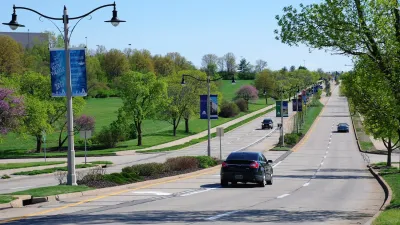A pointed editorial decries the over-regulation that has followed the renaissance of public spaces in Los Angeles.

"In recent years, Los Angeles has invested mightily in its public spaces in efforts to create a 'world class city,'" according to an op-ed by Laura Barraclough. "Great Streets Initiative, to the pop-up parklets and plazas being created along the L.A. River and all around the city, a certain energy around a revitalized public sphere pervades the air," adds Barraclough.
Despite these high profile efforts, however, Barraclough sees reasons to wonder whether the city is living up to its potential—or its promises. She writes: "From the loudly-hyped debut of Grand Park, to Mayor Eric Garcetti's Great Streets Initiative, to the pop-up parklets and plazas being created along the L.A. River and all around the city, a certain energy around a revitalized public sphere pervades the air. Much has been made of the design element of this revitalization, which is crucial, but little has been said of its legal architecture: the hundreds of municipal codes that regulate the city’s public spaces, often in exclusionary ways."
Barraclough lists a surprising inventory of regulations of these spaces, made in the name of public safety. Nearby jurisdictions are just as likely to enact exclusionary regulations. A new dog park in Beverly Hills, for example, will only be open to the city's residents.
After listing several reasons why such regulations unfairly exclude populations that need the space the most, Barraclough goes on to cite Jane Jacobs and William Whyte in presenting a case for more democratic use of public spaces.
FULL STORY: If L.A. wants to be a world class city, it needs to stop micromanaging its public spaces

Planetizen Federal Action Tracker
A weekly monitor of how Trump’s orders and actions are impacting planners and planning in America.

USGS Water Science Centers Targeted for Closure
If their work is suspended, states could lose a valuable resource for monitoring, understanding, and managing water resources.

End Human Sacrifices to the Demanding Gods of Automobile Dependency and Sprawl
The U.S. has much higher traffic fatality rates than peer countries due to automobile dependency and sprawl. Better planning can reduce these human sacrifices.

Trump: Federal Government Won’t Pay for California HSR
The President has targeted federal funding for the California bullet train project since his first administration.

San Francisco Enhances Urban Planning Initiatives with Green Infrastructure
San Francisco incorporates green infrastructure in its city development initiatives, elevating the importance of sustainability in urban planning.

Chicago Approves Green Affordable Housing Plan
The Mayor’s plan calls for creating a nonprofit housing corporation tasked with building affordable housing that meets Green Building standards.
Urban Design for Planners 1: Software Tools
This six-course series explores essential urban design concepts using open source software and equips planners with the tools they need to participate fully in the urban design process.
Planning for Universal Design
Learn the tools for implementing Universal Design in planning regulations.
Tyler Technologies
New York City School Construction Authority
Village of Glen Ellyn
Transportation Research & Education Center (TREC) at Portland State University
Chaddick Institute at DePaul University
Institute for Housing and Urban Development Studies (IHS)
Regional Transportation Commission of Southern Nevada
Toledo-Lucas County Plan Commissions





























